When Hokkaido’s long winter finally ends and the warm sun returns in late April, Hokkaido’s cherry blossoms bloom and flower season arrives.
Here we’d like to tell you about some of the best spring sakura spots!
Why not come see the cherry blossoms that make Hokkaido spring so lovely?

1 Focus on Hokkaido’s vividly colored cherry blossoms.
Hokkaido actually has sakura spots getting attention from cherry blossom lovers all over Japan.
You can see a wide variety of cherry trees all over Hokkaido’s wide spaces, including Somei Yoshino, which makes up 80% of the cherry trees in Japan, as well as Hokkaido’s symbolic Ezoyamazakura, and Chishimazakura, the latest blooming cherry in Japan.

Most people imagine sakura blossoms to be light pink, but many find Hokkaido’s to be particularly vivid and colorful. This is due to the many Ezoyamazakura trees around Hokkaido, as well as the fact that the terrible winter cold makes Hokkaido’s Ezoyamazakura much more deeply colored than those on Honshu.
When you come see the sakura in Hokkaido, make sure you focus on the color!
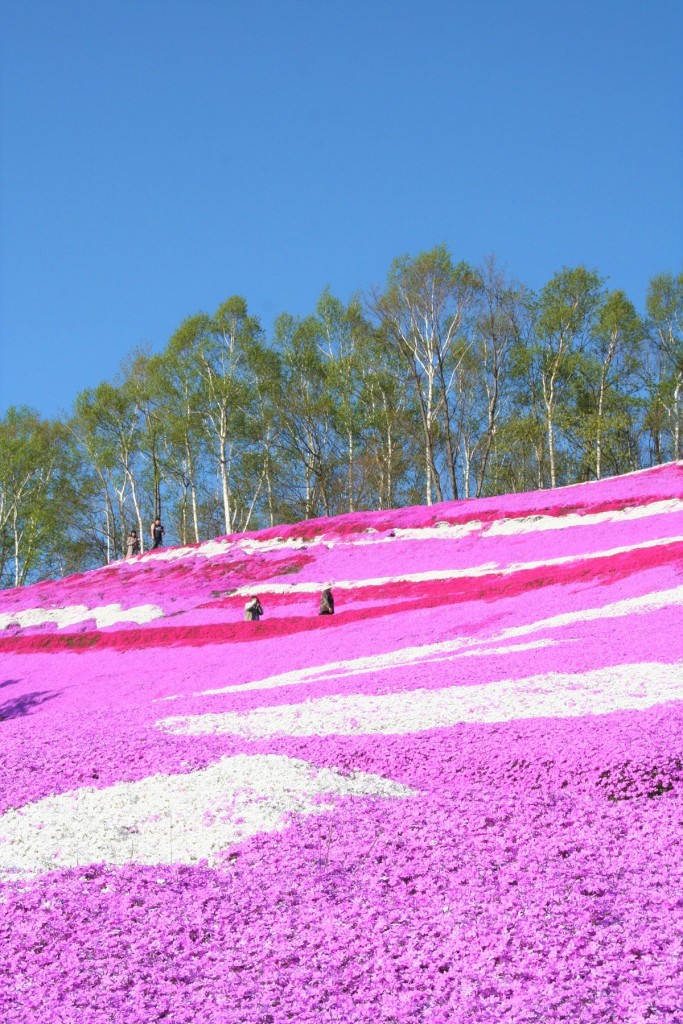
There is one more spring flower you simply shouldu’t miss when you visit Hokkaido.
That’s the moss phlox, also known as “shibazakura,” which blooms pink and white in wide swathes, like a colorful carpet covering the ground.
The sight of blooming moss phlox turning the ground all around you into a delicately colored panorama is truly a sight to remember!
2 When do Sakura and moss phlox bloom in Hokkaido?
Snowy Hokkaido’s sakura season is a little later than Honshu’s, and the moving northward in ascending order Cherry Blossom Front reaches the island’s southern tip at Hakodate and Matsumae in late April, marking the start of the cherry blossom season in Hokkadio.
From early to mid-May it reaches the Sapporo metropolitan area, and mid-May is the time to enjoy sakura in the east Hokkaido area.
The best season for moss phlox is from mid-May to mid-June, when you can see the world all around dyed pale pink with shibazakura blossoms.
3 Hokkaido’s Best3 Sakura Spots
■ Goryokaku Park -Amazing the Star Shaped Sakura!
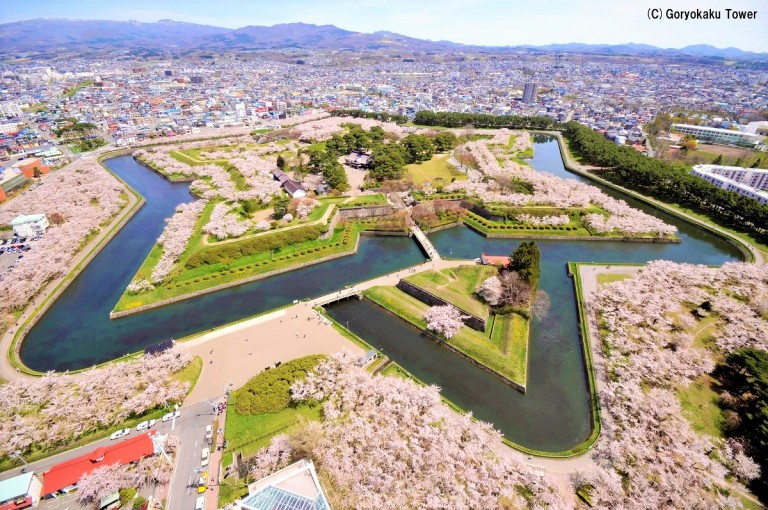
Best Season:Late April – Early May
Goryokaku is a designated national historic landmark, and is Japan’s first European style fort. Its star-shaped fortress carries a real impact.We highly recommend coming in late April to early May to catch the sight of 1,600 Somei Yoshino lining the fortress in full bloom.
Be sure to check the reflection of the cherry trees in the moat! At the end of the season, the fallen cherry petals completely cover the surface of the moat, creating a somehow elegant scene.
Also, you must get a view of the sakura from Goryokaku Tower during your park hanami party. The tower is 90 meters tall and the glass walled observation platform offers a 360-degree view of the whole of Goryokaku. The sight of Goryokaku’s star-shaped moat completely covered with pink petals is breath-takingly beautiful.
You’re guaranteed to be moved by the sight of this sparkling pink star!
Address: Goryokaku 44, Hakodate
Getting There: Take a Tram from “Hakodate Ekimae” stop in front of JR Hakodate Station to “Goryokaku Koen-mae”,walk 15 minutes
URL:https://www.hakodate.travel/en/
■Overwhelming Sakura Scenery! Matsumae Park – boasts around 10,000 cherry trees of about 250 varieties!
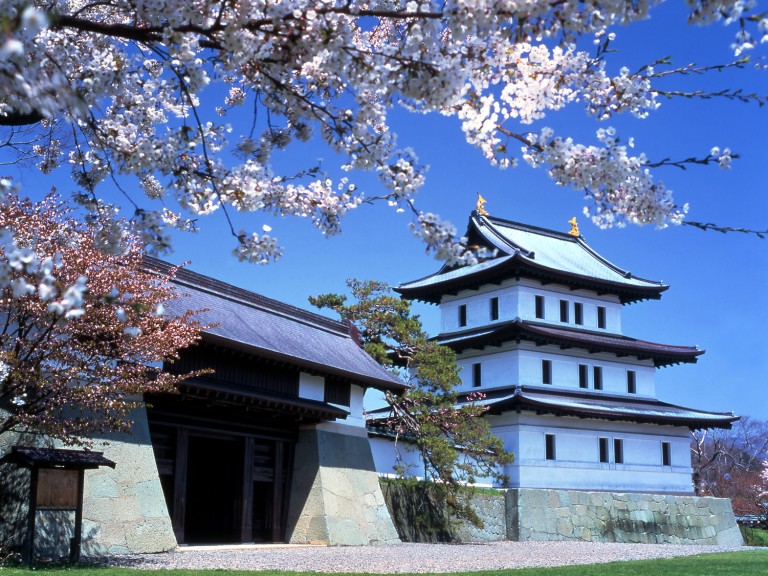
Best Season: Late April – Mid-May
Matsumae,Japan’s northernmost castle town, keeps Edo period atmosphere around Matsumae Castle and the temple district. The town is a famous cherry blossom destination, with a month-long season lasting from late April to late May.
You can see about 10,000 beautiful cherry trees here, in over 250 varieties including some new types born right here. They say the origin of these trees dates dates back to when rich Merchants of the town or brides of the Matsumae Clan brought the sakura trees with them. and more were brougnt here when the feudal retainers of the clan returned from their residence in Ezo.
The interplay of early, middle, and late blooming trees, combined with the view over the Tsugaru Strait, is truly incredible.
Matsumae Park, which houses Matsumae Castle, is particularly impressive with about 8,000 trees itself, including Matsumae’s own variety Naden, and is Hokkaido’s only place to enjoy a castle view amidst the sakura. Must-sees include the “Three Great Mastumae Sakura”: The Couple’s Sakura, where a Somei Yoshino and Nedan grow from one root; the ancient Kechimyaku-zakura certified as over 300 years old; and the Ezo-kasumi-zakura cherry tree found within the Ryuun Temple grounds, Matsumae’s oldest temple.
Address: Matsushiro, Matsumae
Getting There: 3 hours 20 minutes by Hakodate Bus from Hakodate.
■Maruyama Park-Sapporo’s best sakura spot only 20 minutes subway ride away
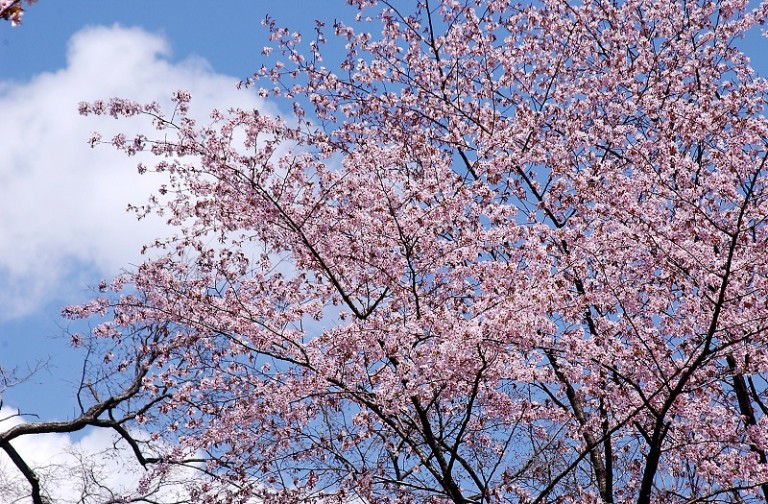
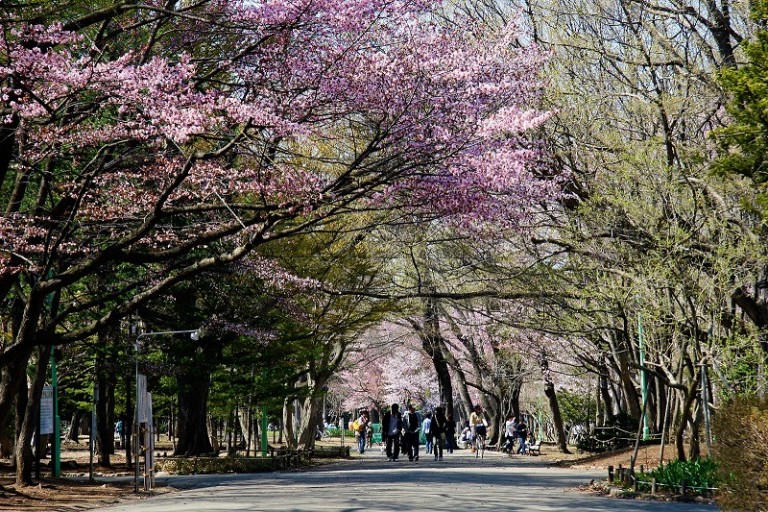
Best Season: Early to Mid-May
Maruyama Park is a lush natural park on the north side of Mt. Maruyama Primeval Forest.
Along with the connected Hokkaido Shrine, this area has long been loved by local residents as a cherry blossom spot, and every year hosts crowds of Hanami revelers.
It sees lots of tourists as well because it’s only 20 minutes by subway from central Sapporo and Odori Park, so it’s easy to add to any Sapporo sightseeing itinerary. There’s a zoo next to Maruyama Park, too, so we recommend it as a great place for guests of all ages to come and have fun.
Address: Miyagaoka, Chuo-ku, Sapporo
Getting There: Take a Subway of Tozai Line to Maruyama koen Station. And 5 minutes’ walk.
http://www.sapporo.travel/find/nature-and-parks/maruyama_park/?lang=en
4 Hokkaido’s Best 3 Moss Phlox Spots
■Shibazakura Takinoue Park – One of Japan’s largest moss phlox areas
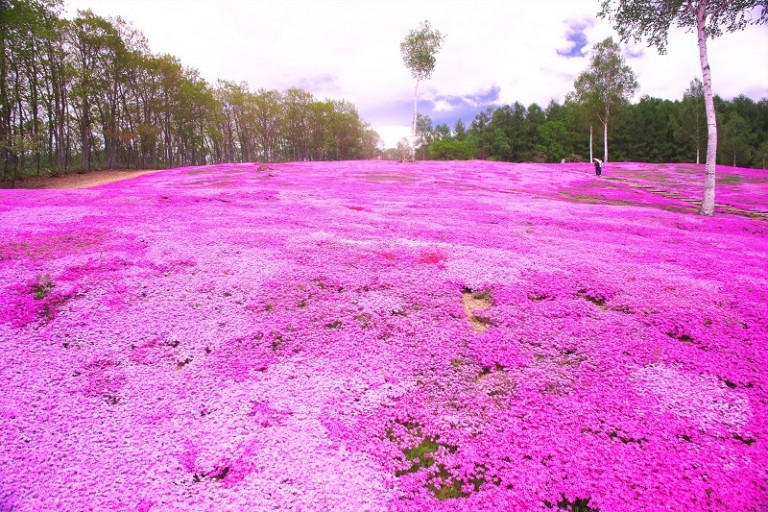
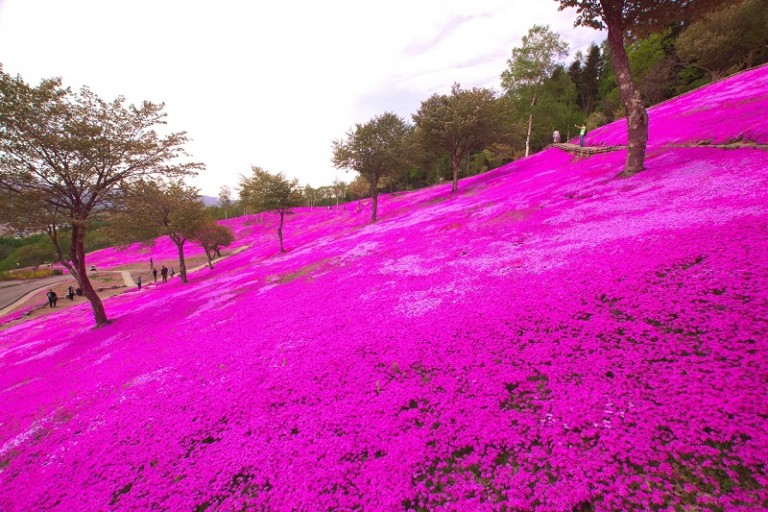
Best Season: Mid-May to Early June
Shibazakura Takinoue Park is on the top of a small hill in Takinoue, and has one of Japan’s largest patches of moss phlox, at 10 hectares.
The sight of moss phlox over the hill is truly incredible! These flowers bloom for about a month, and not only do they paint the area in bright colors but also give off a sweet aroma which blankets the town.
Every year sees the Takinoue Shibazakura Festival from early May to early June. During the festival, you can take helicopter rides to see the park from the sky and enjoy the contrast of the pink moss phlox against the blue sky. It’s an experience you can’t have any other time!
If you visit the park during the event, make sure you give it a try.
Address: Motomachi, Takinoue
Getting There: From Sapporo take a coach “Ryuhyo Mombetsu Liner”3houes and half by a direct route,or 4 hours and half via Asahikawa. From “Takinoue”bus stop 10 minutes walk to the park.
■Higashimokoto Shibazakura Park -A hill with pink gradation
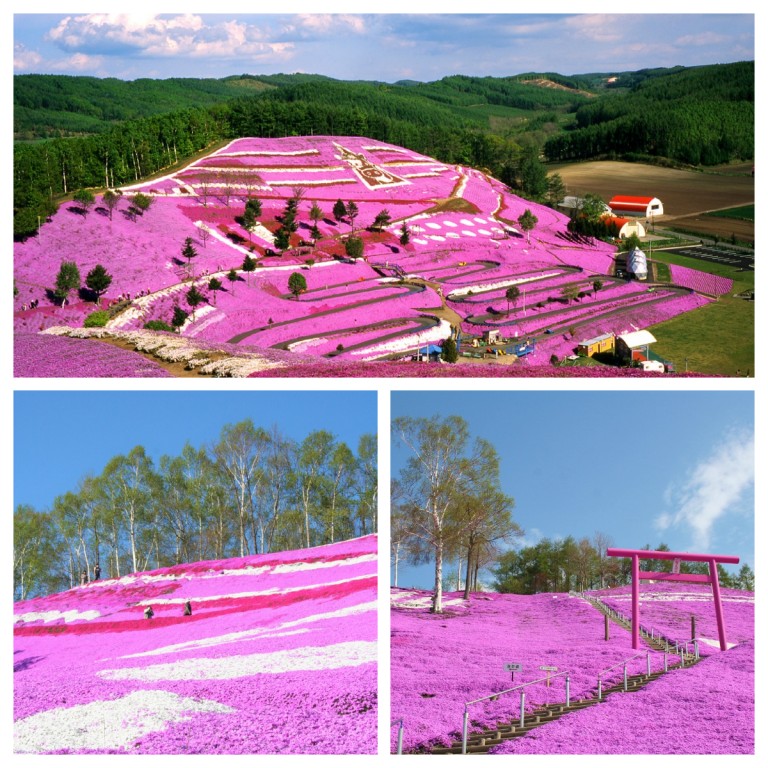
Higashimokoto Shibazakura Park draws flocks of tourists every year.
This moss phlox park spreads out over 10 hectares, and the hillside is painted pink from early May through early June. The various shades of pink covering the entire hill make a simply incredible sight!
The gentle hillside with its carpet of moss phlox is stunning whether viewed from below, or looking down from the top. And Yamatsumi Shrine with its pink torii gate is another spectacular photo spot. stop and enjoy the flowers while you stroll through the park.
Address: Higashimokoto Shibazakura Park 393 Suehiro, Higashimokoto, Ozora
Getting There: 45 minutes’ drive from Memanbetsu Airport
■ Mishima-san’s Shibazakura Park -A perfect match of Sakura and canola flower !
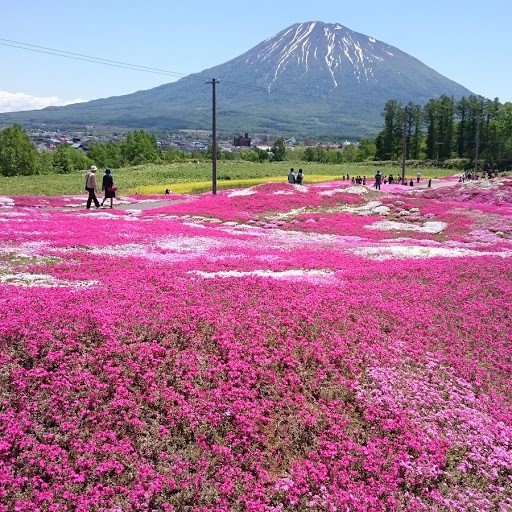
Best Season: Late May – Early June
This moss phlox spot has got lots of attention recently, with its easy distance from Sappooro . It’s in the Niseko area, a great place to enjoy outdoor activities in Hokkaido’s grand natural landscape, and in winter the incredible powder snow brings ski fans from all over the world,
And the spot is called “Mishima-san’s Shibazakura Park”.
This is actually the private lawn of former farmer Kazuo Mishima. It’s also one of the few places in Hokkaido where you can see a wide swathe of moss phlox and a canola flower field at the same time.
The multihued blossoms of cherry, phlox and canola flower create a spectacle of contrasts that’s simply breathtaking.
This moss phlox and nanohana field is all hand-raised by Mr. Mishima through hard, careful work.
The white and pink moss phlox was planted in a way to create a lovely contrast against the still snowy Mt. Yotei and the Niseko mountain range.
Address: 51 Asahi, Kutchan
Getting There: Get off at JR Kutchan Station. It’s a 15-minute walk.
Note: The owner kindly opens this area to public viewing but it remains private property. Please mind your manners while visiting.